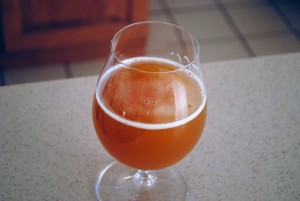 Couple things with this beer I didn’t like. First, I forgot I had run out of Irish moss so the beer is super cloudy from the oatmeal. Second, this is my first real hop bomb I’ve made with Ventura water and something wasn’t tasting quite right. I had noticed it a little with the hefe and the Belgian pale ale I brewed a few months ago – a kind of dryness to the palette. Not unpleasant and I attributed it to the high carbonation rate. This time I knew I had to review the water report because the upfront bitterness is a bit harsh on this beer and this is a beer that is bittered by late hop additions, which some believe add a smoother bitterness.
Couple things with this beer I didn’t like. First, I forgot I had run out of Irish moss so the beer is super cloudy from the oatmeal. Second, this is my first real hop bomb I’ve made with Ventura water and something wasn’t tasting quite right. I had noticed it a little with the hefe and the Belgian pale ale I brewed a few months ago – a kind of dryness to the palette. Not unpleasant and I attributed it to the high carbonation rate. This time I knew I had to review the water report because the upfront bitterness is a bit harsh on this beer and this is a beer that is bittered by late hop additions, which some believe add a smoother bitterness.
So after reviewing the water report, lo and behold, Ventura water is super hard, especially in bicarbonates, which will make the bitterness from hops seem harsh. Not only is temporary hardness (bicarbonate) high, the permanent (sulphate) hardness is really high which could be producing astringency because water high in sulphates causes astringency in general – an almost dry slightly metallic taste.
Appearance of the beer is a nice golden orange hue from the Vienna malt. Clarity is turbid to say the least. Hop nose is over the top and wonderful. The 11 ounces of hops were late addition, flame out and dry hops. No bittering hops were added and all the IBUs were from 15 minute additions. This contributes to the huge hop aroma and flavor. Once your nose has sucked in the aromas the bitterness whacks your tongue a bit too harshly as mentioned above. The beer was estimated at around 37 IBU but tastes much higher. Body is thin but the addition of the oatmeal gives it a bit more mouth feel and the finish is smooth with a lingering bitterness.
Good beer but not great. The harsh bitterness up front ruins it for me. I think if the water was treated appropriately it would be an awesome beer. Might have to redo this one in the near future.